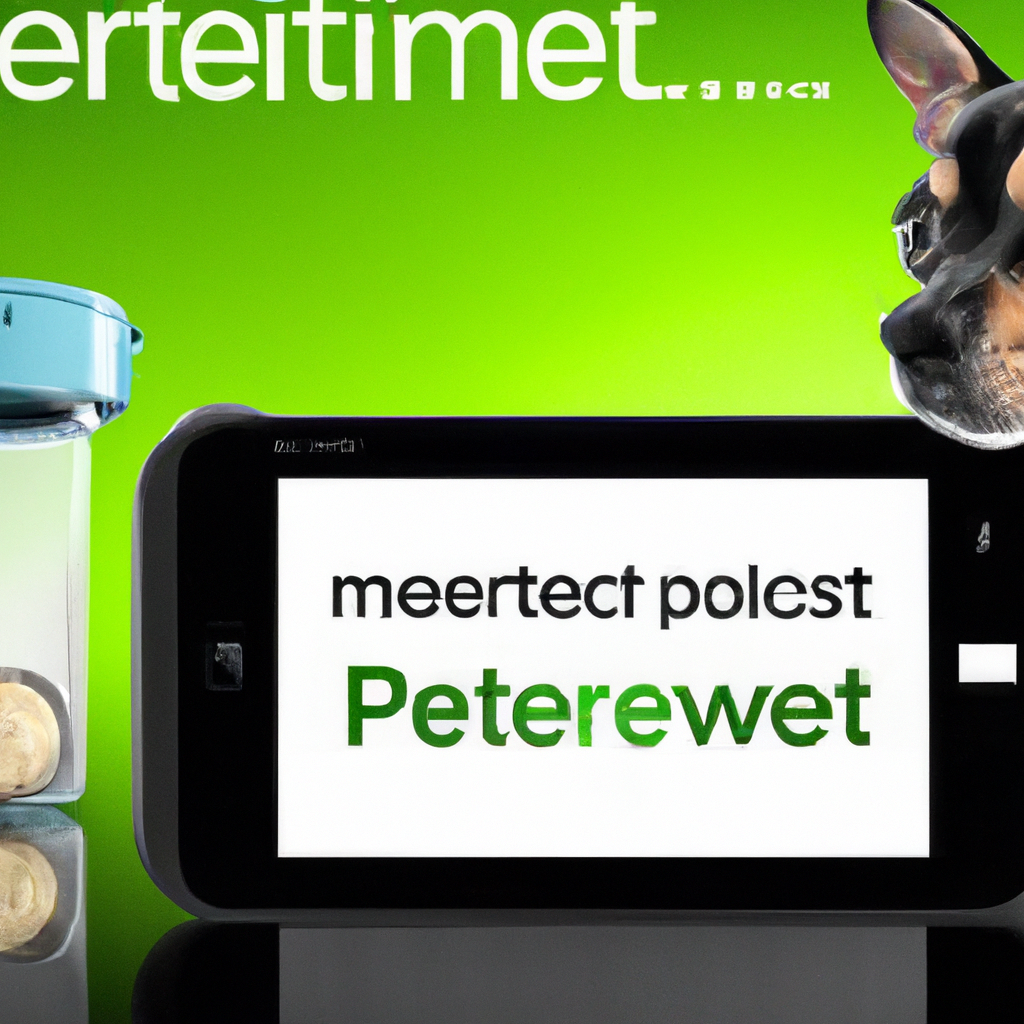If you’ve ever found yourself wondering about how much your furry companion is eating and drinking throughout the day, you’ll be pleased to know that smart devices might just have an answer for you. With advancements in technology, pet owners can now monitor their pet’s food and water intake with ease. These smart devices provide real-time information and allow you to keep track of your pet’s nutrition, ensuring they are getting the right amount of sustenance to stay healthy and happy. Say goodbye to the guesswork and hello to a more informed approach to caring for your four-legged friend.
Overview
Definition of Smart Devices
Smart devices are electronic devices that have the ability to connect to the internet and other devices, allowing for seamless communication and control. In the context of pet monitoring, smart devices are specifically designed to help pet owners keep track of their pet’s food and water intake. These devices are equipped with innovative features that provide convenience, accuracy, and peace of mind.
Importance of Monitoring Pet’s Food and Water Intake
Monitoring your pet’s food and water intake is crucial for their overall health and well-being. By keeping track of what they eat and drink, you can ensure they are getting the right amount of nutrition and hydration. It also allows you to spot any changes in their eating habits, which can be an early indication of potential health issues. With smart devices, you can easily and accurately monitor your pet’s food and water intake, providing you with insights and control over their diet.
Types of Smart Devices for Pet Monitoring
Smart Pet Feeders
Smart pet feeders are automated food dispensers that allow you to schedule and control your pet’s feeding times. These devices can be programmed to dispense specific portion sizes at designated times throughout the day. They often come with user-friendly interfaces that allow you to customize feeding schedules and monitor feeding history.
Water Dispensers
Water dispensers are smart devices that automatically refill your pet’s water bowl as needed. They are equipped with sensors that detect the water level and dispense fresh water when it runs low. Some water dispensers even have filtration systems that ensure your pet is drinking clean and purified water.
Activity Trackers
Activity trackers are smart devices that monitor your pet’s daily activity levels, including steps taken, calories burned, and sleep patterns. These devices can provide valuable insights into your pet’s overall health and fitness. By tracking their activity, you can ensure they are getting enough exercise and identify any changes in their behavior or energy levels.
Smart Bowls
Smart bowls are designed to measure the exact amount of food or water your pet consumes. These bowls are usually equipped with built-in scales or sensors that accurately monitor the quantity of food or water. By using a smart bowl, you can ensure your pet is getting the right portion sizes and avoid overfeeding or underfeeding.

Features of Smart Devices
Automated Feeding Schedule
One of the key features of smart pet feeders is the ability to set automated feeding schedules. You can program the feeder to dispense food at specific times throughout the day, ensuring that your pet receives their meals on time. This is especially useful if you have a busy schedule or if you are away from home for extended periods.
Portion Control
Smart devices for pet monitoring often come with portion control features, allowing you to regulate the amount of food or water your pet consumes. By setting specific portion sizes, you can prevent overeating or underfeeding, promoting a healthy diet for your pet. This feature is particularly beneficial for pets with specific dietary needs or weight management requirements.
Notification Alerts
With smart devices, you can receive real-time notification alerts about your pet’s feeding and drinking habits. If your pet misses a meal or if the water level is low, you will be immediately alerted through your smartphone or other connected devices. These alerts ensure that you stay informed about your pet’s well-being and can address any issues promptly.
Water Level Monitoring
Water dispensers equipped with water level monitoring sensors can accurately detect when the water level is running low. This feature allows the dispenser to automatically refill the water bowl, ensuring that your pet always has access to fresh water. By monitoring the water level, you can be confident that your pet is staying hydrated throughout the day, even when you are not at home.
Meal Logging
Smart devices often come with meal logging capabilities, allowing you to keep track of your pet’s eating habits over time. With this feature, you can record the type of food, portion sizes, and feeding times. This information can be helpful for monitoring your pet’s dietary consistency, identifying any changes in appetite, and sharing feeding data with your veterinarian if necessary.
Feeding History
Smart devices with feeding history features store data related to your pet’s feeding patterns and history. This data can be accessed through a mobile app or online platform, providing you with a comprehensive overview of your pet’s eating habits. By reviewing the feeding history, you can identify any irregularities or changes in behavior and adjust their diet accordingly.
Remote Access
Smart pet monitoring devices often allow for remote access, giving you the ability to control and monitor your pet’s food and water intake even when you are not at home. Through a mobile app or online portal, you can adjust feeding schedules, dispense food or water, and receive real-time alerts. This feature provides flexibility and peace of mind, especially for pet owners with busy lifestyles or travel frequently.
Integration with Smart Home Systems
Many smart devices are designed to integrate seamlessly with existing smart home systems. This integration allows you to control and monitor your pet’s food and water intake through voice commands or via other smart devices in your home network. For example, you can use a voice assistant to dispense food or check the water level in your pet’s bowl. This integration adds an extra layer of convenience and simplifies the monitoring process.
Benefits of Using Smart Devices
Improved Convenience
One of the main benefits of using smart devices for pet monitoring is the convenience they offer. With automated feeding and water dispensing schedules, you no longer have to worry about being at home to feed your pet on time. Smart devices also eliminate the need for manual portion measurements, saving you time and effort. The ability to remotely control and monitor your pet’s food and water intake further enhances convenience, allowing you to take care of their needs even when you are away.
Health Monitoring
Smart devices provide valuable insights into your pet’s health by monitoring their food and water intake. By accurately tracking their eating and drinking habits, you can spot any changes in appetite or excessive thirst, which may indicate underlying health issues. Additionally, activity trackers can help you assess your pet’s overall fitness and ensure they are getting enough exercise. These health monitoring features enable you to take proactive measures to maintain your pet’s well-being.
Portion Control and Weight Management
Maintaining proper portion sizes and managing your pet’s weight is essential for their overall health. With smart devices, you can set specific portion sizes and feeding schedules, ensuring that your pet receives the appropriate amount of food. This feature is particularly helpful for pets with weight management needs or those on specific diets. By accurately measuring and controlling portions, you can help prevent obesity and other weight-related health problems.
Early Detection of Potential Health Issues
Regularly monitoring your pet’s food and water intake allows you to detect any potential health issues early on. Changes in appetite, excessive thirst, or sudden fluctuations in weight can be warning signs of underlying medical conditions. By keeping a close eye on their eating and drinking habits through smart devices, you can spot these signs quickly and seek veterinary advice as needed. Early detection can lead to timely intervention and better treatment outcomes for your beloved pet.

Considerations Before Purchasing
Pet’s Dietary Needs
Before purchasing any smart devices for pet monitoring, it is essential to consider your pet’s specific dietary needs. Different devices may have varying capabilities in terms of portion control, food types, and compatibility with certain diets. Consult with your veterinarian to ensure that the smart devices you choose align with your pet’s nutritional requirements.
Pet’s Behavior and Adaptability
Not all pets adapt easily to new devices or changes in their routine. Take into account your pet’s behavior and temperament when choosing smart devices for pet monitoring. Some pets may be easily overwhelmed or intimidated by automated feeders or water dispensers. Consider their comfort level and assess whether they would accept and use the device without any issues.
Compatibility with Existing Pet Accessories
If you already have existing pet accessories, such as bowls or collars, it is important to consider their compatibility with the smart devices you plan to purchase. Some devices may require specific accessories or attachments. Ensure that the smart devices you choose can seamlessly integrate with your existing pet accessories, providing a hassle-free user experience.
Budget and Pricing
Smart devices for pet monitoring can vary in price, depending on their features and capabilities. Before making a purchase, determine your budget and consider the long-term costs, including maintenance and potential subscription fees for accessing additional features. Compare different smart devices and choose the ones that best fit your budget without compromising on quality and functionality.
Setting Up Smart Devices
Installation Process
The installation process for smart pet monitoring devices is typically straightforward and user-friendly. Follow the manufacturer’s instructions provided with the device to assemble and set it up correctly. Most devices require minimal assembly and can be ready to use within a few minutes.
Configuration and App Setup
To fully utilize the features of smart devices, you will need to configure and set up a corresponding mobile app or access a dedicated online portal. Download the app from the respective app store and follow the instructions to create an account and pair the device with your smartphone or other connected devices. The app setup usually involves connecting to the device via Bluetooth or scanning a QR code.
Connecting to Wi-Fi
To enable remote access and real-time monitoring, ensure that your smart pet monitoring devices are connected to a reliable Wi-Fi network. Following the in-app instructions, connect the device to your home Wi-Fi network by entering the network credentials. Once successfully connected, you can control and monitor your pet’s food and water intake from anywhere with an internet connection.
Syncing with Mobile Devices
After completing the initial setup, you may need to sync the smart device with your mobile devices. This synchronization allows for seamless communication and ensures that you receive real-time notifications and updates. Follow the instructions provided by the manufacturer to sync your smart pet monitoring devices with your preferred mobile devices.

Ensuring Accuracy of Monitoring
Calibration of Smart Devices
To ensure accurate monitoring, it is important to calibrate your smart devices properly. Calibration procedures may vary depending on the device, but they usually involve setting the correct portion sizes or water level. Follow the instructions provided by the manufacturer to calibrate your device accurately. Regularly check and adjust the calibration as needed to ensure precise measurements.
Regular Maintenance
Just like any other electronic device, smart pet monitoring devices require regular maintenance to ensure optimal performance. Clean the device and its components regularly, following the manufacturer’s guidelines. This will help prevent clogs, malfunctions, and ensure proper hygiene for your pet. Additionally, check for any signs of wear and tear and replace any worn-out parts promptly to avoid potential issues.
Data Validation
To ensure the accuracy of the data collected by smart devices, it is essential to validate and cross-reference it with other sources. Keep a record of your pet’s feeding and drinking habits manually and compare them with the data provided by the smart device. This validation process will help you identify any discrepancies and adjust the device settings if necessary. Regular manual validation will ensure that you have reliable data for monitoring your pet’s food and water intake.
Addressing Privacy and Security Concerns
Data Privacy
When using smart devices for pet monitoring, it is crucial to ensure the privacy and security of your pet’s data. Choose devices and apps from reputable manufacturers that prioritize data privacy. Review the privacy policy and terms of service to understand how data is stored, used, and shared. Opt for devices that let you control the level of data sharing and provide secure encryption for transmitting data.
Security Measures
To protect your pet’s data and prevent unauthorized access, it is important to implement basic security measures. Set strong and unique passwords for your devices and mobile apps, and avoid using default or easily guessable passwords. Regularly update the device firmware and mobile apps to ensure they have the latest security patches. Enable device lock features to prevent unauthorized physical access to the device.
Vendor Reputation and Reviews
Research the reputation of the vendor or manufacturer before purchasing any smart devices for pet monitoring. Look for customer reviews and testimonials to gauge the overall satisfaction and reliability of the products. Pay attention to any security breaches or privacy concerns reported by other users. Choosing devices from reputable vendors minimizes the risk of potential privacy and security issues.

Potential Limitations of Smart Devices
Reliance on Technology
Smart devices are reliant on technology and can be prone to technical glitches or malfunctions. Power outages, connectivity issues, or device failures can disrupt the monitoring process. It is important to have alternative contingency plans in place, such as backup food and water arrangements, to ensure your pet’s needs are met even if the smart devices face any interruptions.
Power Outages and Connectivity Issues
Smart pet monitoring devices require a stable power supply and an active internet connection to function properly. Power outages can disrupt the feeding and water dispensing schedules. Similarly, connectivity issues may result in delayed notifications or loss of access to device controls. Consider investing in backup power sources, such as battery backups or uninterruptible power supply (UPS), to mitigate the impact of power outages. Additionally, ensure that your internet connection is reliable and consider having a backup connection if necessary.
Potential Malfunctions
Smart devices, like any electronic device, can experience malfunctions or technical issues. The sensors or mechanisms responsible for measuring and dispensing food or water may fail, leading to inaccurate readings or disruptions in the feeding process. Regularly check the devices for any signs of malfunction and contact the manufacturer for support or to initiate warranty claims if needed.
Conclusion
Smart devices for pet monitoring provide numerous benefits, such as convenience, health monitoring, portion control, and early detection of potential health issues. By accurately tracking your pet’s food and water intake, you can ensure their well-being and respond promptly to any changes in their habits. However, it is important to consider your pet’s specific dietary needs and adaptability, as well as address privacy and security concerns. By following proper setup procedures, ensuring accuracy through calibration and data validation, and understanding the limitations of smart devices, you can make an informed decision to enhance your pet’s care and monitor their food and water intake effectively.











